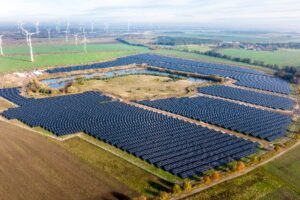Balancing Renewable Power and Environmental Concerns

Hydroelectric energy, often considered as a clean and renewable energy source, has been harnessed for centuries to generate electricity. This form of power generation relies on the force of flowing water, typically from rivers or dams, to spin turbines and produce clean electricity. However, it seems that there is a hydroelectric energy environmental impact.
While hydroelectric energy offers numerous benefits, including reduced greenhouse gas emissions and reliable power generation, it is not without its environmental impact. In this comprehensive article, we will delve into the environmental implications of hydroelectric energy, exploring both its advantages and the challenges it poses in achieving a sustainable energy future.
Advantages of Hydroelectric Energy
Low Greenhouse Gas Emissions
Hydroelectric power is considered one of the cleanest forms of energy generation. Unlike fossil fuels, it produces minimal greenhouse gas emissions, making it a crucial component of efforts to combat climate change.
Reliable and Renewable
Hydroelectric power plants can provide a consistent and reliable source of electricity. Unlike some other renewable energy sources, such as solar and wind, hydroelectric power generation is not dependent on weather conditions.
Energy Storage
Some hydroelectric power plants can serve as energy storage systems by adjusting water flow and generation levels to meet demand. This flexibility contributes to grid stability.
Flood Control and Irrigation
Many dams used for hydroelectric power generation serve additional purposes, such as flood control and irrigation. These functions can be crucial for managing water resources in regions prone to floods or droughts.
Long Lifespan
Hydroelectric power plants have long lifespans, often exceeding 50 years. This durability reduces the need for frequent replacement and maintenance.
Environmental Concerns Associated with Hydroelectric Energy
Disruption of Aquatic Ecosystems
The construction of dams can significantly alter the natural flow of rivers and waterways, impacting aquatic ecosystems. Changes in water temperature, sediment transport, and fish migration can harm local biodiversity.
Loss of Habitats
Reservoir creation due to dam construction can lead to the submersion of large areas of land, including forests and wetlands. This loss of habitat can have far-reaching ecological consequences.
Methane Emissions
In some cases, submerged organic matter in reservoirs can produce methane, a potent greenhouse gas. While the emissions are generally lower than those from fossil fuels, they still contribute to global warming.
Sediment Accumulation
Dams can trap sediment that would naturally flow downstream. This can result in downstream erosion, altered riverbeds, and reduced water quality.

Hydroelectric power plant built over a fast river, image source: Pixabay
Altered River Flow
The natural flow of rivers and waterways is essential for nutrient transport, sediment dispersal, and maintaining the health of downstream ecosystems. Dams can disrupt these critical processes.
Balancing Hydroelectric Energy and Environmental Conservation
The environmental impact of hydroelectric energy varies depending on factors such as dam size, location, and design. To strike a balance between harnessing its benefits and mitigating its environmental effects, several strategies and technologies are being employed:
Fish Ladders and Bypasses
To facilitate fish migration and protect aquatic life, fish ladders and bypasses are incorporated into dam designs. These structures help fish navigate around barriers.
Environmental Flow Releases
Careful management of water release schedules from dams can mimic natural river flows and maintain the health of downstream ecosystems.
Small and Micro Hydropower
Smaller hydroelectric installations, such as micro and run-of-river projects, have a reduced environmental footprint compared to large dams. They can be designed to minimize habitat disruption.
Eco-Friendly Turbines
The use of fish-friendly turbines and technologies can reduce harm to aquatic life during power generation.
Hydroelectric Decommissioning
In some cases, older hydroelectric facilities that have reached the end of their operational life are being decommissioned to restore natural river ecosystems.
Innovations in Hydroelectric Energy for a Sustainable Future
The pursuit of sustainable energy solutions has led to ongoing advancements in hydroelectric technology and practices, aiming to minimize its environmental impact while maximizing its benefits. Here are some key innovations and strategies in the realm of hydroelectric energy:
1. Turbines Friendlier with Marine Life
Traditional turbines used in hydroelectric power generation can be harmful to fish and other aquatic life. However, modern fish-friendly turbine designs are being developed and adopted. These turbines minimize the risk of injury or mortality to fish during their passage through the turbines.
2. Environmental Flow Management
Maintaining natural river flows is essential for downstream ecosystems. Innovative environmental flow management techniques are being employed to release water in patterns that mimic natural flow regimes, ensuring the health of aquatic habitats.
3. Hydropower Upgrades
Existing dams and hydroelectric facilities are being retrofitted with upgraded technologies that improve energy efficiency and reduce environmental impact. These upgrades can include more efficient turbines and fish passage systems.
4. Mini and Micro Hydropower
Mini and micro hydropower projects are gaining popularity, particularly in remote or off-grid areas. These smaller installations have a reduced environmental footprint compared to large dams and are designed to minimize habitat disruption.
5. Run-of-River Hydropower
Run-of-river hydropower projects are designed to harness the kinetic energy of flowing water without creating large reservoirs. These systems have a lower environmental impact as they maintain natural river flows and habitats.
6. Smart Grid Integration
Hydroelectric power generation can be integrated into smart grid systems that allow for efficient distribution and management of electricity. This integration helps balance supply and demand while minimizing waste.

Hoover Dam in Nevada, image source: Pixabay
7. Decommissioning and Dam Removal
In cases where the environmental impact of a dam outweighs its benefits, decommissioning and dam removal projects are being considered. These initiatives aim to restore natural river ecosystems and habitats.
8. Pumped Hydro Storage
Pumped hydro storage is a form of hydroelectric energy storage that helps stabilize the electrical grid. During periods of excess electricity generation, water is pumped uphill to a reservoir, and during peak demand, it flows downhill to generate electricity.
9. Climate-Resilient Hydropower
Climate change poses challenges to hydropower due to changing precipitation patterns and extreme weather events. Climate-resilient hydropower projects are being designed to adapt to these changing conditions.
10. Multi-Purpose Dams
Some dams serve multiple purposes beyond power generation, such as water supply, flood control, and recreation. These multi-purpose dams aim to strike a balance between human needs and environmental conservation.
Conclusion: A Path to Sustainable Hydroelectric Energy
The quest for sustainable energy sources is an ongoing journey that requires innovation, adaptability, and a commitment to environmental stewardship. Hydroelectric energy, with its rich history and potential, plays a vital role in our renewable energy portfolio.
By embracing technological advancements, improving environmental practices, and considering the long-term impact of hydroelectric projects, we can harness the power of flowing water while minimizing harm to aquatic ecosystems and habitats.
The path to sustainable hydroelectric energy lies in a thoughtful and balanced approach that prioritizes both our energy needs and the well-being of our natural world. With continued dedication to innovation and conservation, hydroelectric energy can remain a key contributor to a cleaner and more sustainable energy future.







